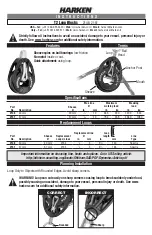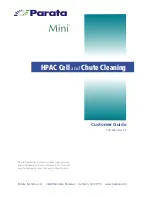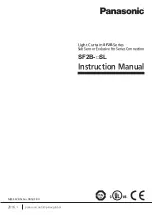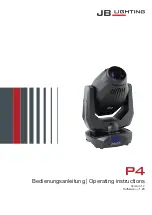
5
OPERATING INSTRUCTIONS
MAINTENANCE SCHEDULE
Perform these required maintenance procedures at the frequency stated in the table. These procedures should also be
a part of any seasonal tune-up.
NOTE:
Some maintenance procedures may require special tools or skills. If you are unsure about these procedures, take
your unit to any non-road engine repair establishment, individual or authorized service dealer.
NOTE:
Maintenance, replacement, or repair of the emission control devices and system may be performed by any
non-road engine repair establishment, individual or authorized service dealer.
NOTE:
Please read the California/EPA statement that came with the unit for a complete listing of terms and coverage
for the emissions control devices, such as the spark arrestor, muffler, carburetor, etc.
MAINTENANCE AND REPAIR INSTRUCTIONS
FREQUENCY
MAINTENANCE REQUIRED
SEE
Before starting engine
Fill fuel tank with fresh fuel
p. 3
Every 10 hours
Clean and re-oil air filter
p. 4
Every 25 hours
Check spark plug condition and gap
p. 4
WARNING:
To prevent serious injury, never perform maintenance or repairs with unit running. Always
service and repair a cool unit. Disconnect the spark plug wire to ensure that the unit cannot start.
HOLDING THE TRIMMER
Before operating the unit, stand in the operating position (Fig. 21). Check for the following:
• The operator is wearing eye protection and proper
clothing
• With a slightly-bent right arm, the operator’s hand is
holding the shaft grip
• The operator’s left arm is straight, the left hand holding the J-
handle
• The unit is at waist level
• The cutting head is parallel to the ground and easily
contacts the grass without the need to bend over
TIPS FOR BEST TRIMMING RESULTS
• Keep the cutting head parallel to the ground.
• Do not force the cutting head. Allow the tip of the line to
do the cutting, especially along walls. Cutting with more than the tip will reduce cutting efficiency
and may overload the engine.
• Cut grass over 8 inches (200 mm) by working from top to bottom in small increments to avoid
premature line wear or engine drag.
• Cut from right to left whenever possible. Cutting to the left improves the unit's cutting efficiency.
Clippings are thrown away from the operator.
• Slowly move the unit into and out of the cutting area at the desired height. Move either in a
forward-backward or side-to-side motion. Cutting shorter lengths produces the best results.
• Trim only when grass and weeds are dry.
• The life of the cutting line is dependent upon:
• Following the trimming techniques
• What vegetation is being cut
• Where vegetation is cut
For example, the line will wear faster when trimming against
a foundation wall as opposed to trimming around a tree.
Some line breakage will occur from:
• Entanglement with foreign matter
• Normal line fatigue
• Attempting to cut thick, stalky weeds
• Forcing the line into objects such as walls or fence posts
DECORATIVE TRIMMING
Decorative trimming is accomplished by removing all vegetation around trees, posts, fences, etc.
Rotate the whole unit so that the cutting head is at a 30° angle to the ground (Fig. 22).
USING THE CUTTING BLADE
Before operating the unit with the cutting blade, stand in the operating position (Fig. 23). Refer to
Holding the Trimmer
.
Cutting Blade Operating Tips
To establish a rhythmic cutting procedure:
• Plant feet firmly, comfortably apart.
• Bring the engine to full throttle before entering the material to be cut. At full throttle the blade has
maximum cutting power and is less likely to bind, stall or cause blade thrust (which can result in
serious personal injury to the operator or others).
• Cut while swinging the upper part of your body from left
to right.
• Always release the throttle trigger and allow the engine to
return to idle speed when not cutting.
• When you are finished, always unsnap the unit from the
harness before taking off the harness.
• Swing the unit in the opposite direction as the blade
spins, which increases the cutting action.
• After the return swing, move forward to the next area to
be cut and plant your feet again.
• The cutting blade is designed with a second cutting
edge. You can use it by removing the blade, turning it
upside down and reinstalling it.
To reduce the chance of material wrapping around the blade,
follow these steps:
• Cut at full throttle.
• Swing the unit into material to be cut from your left to
your right (Fig. 24).
• Avoid the material just cut as you make the return swing.
WARNING:
Always wear eye, hearing, foot and body protection to reduce the risk of injury
when operating this unit.
Fig. 21
Fig. 22
WARNING:
Always wear eye, hearing, foot, body protection and the shoulder strap to reduce
the risk of injury when operating this unit.
WARNING:
Do not use the cutting blade for edging or as an edger. Severe personal injury
to yourself or others can result.
WARNING:
Blade thrust may occur when the spinning blade contacts an object that it
does not immediately cut. Blade thrust can be violent enough to cause the unit and/or operator to
be propelled in any direction, and possibly lose control of the unit. Blade thrust can occur without
warning if the blade snags, stalls or binds. This is more likely to occur in areas where it is difficult
to see the material being cut.
WARNING:
The blade continues to spin after
the engine is turned off. The coasting blade can
seriously cut you if accidentally touched.
WARNING:
Do not clear away any cut material with the engine running or blade turning. To
avoid serious personal injury, turn off the engine. Allow the blade to stop before removing
materials wrapped around the blade shaft.
Fig. 23
Fig. 24
LINE INSTALLATION
This section covers both SplitLine™ and standard single line installation.
Always use original equipment manufacturer 0.105 in. (2.67 mm) replacement line. Other types of line
may make the engine overheat or fail.
There are two methods to replace the trimming line:
• Wind the inner reel with new line
• Install a prewound inner reel
Winding the Existing Inner Reel
1. Hold the outer spool with one hand and unscrew
the Bump Knob clockwise (Fig. 25). Inspect the
bolt inside the bump knob to make sure it moves
freely. Replace the bump knob if damaged.
2. Remove the inner reel from the outer spool (Fig.
25).
3. Remove spring from the inner reel (Fig. 25).
4. Use a clean cloth to clean the
the inner reel, spring, shaft and
inner surface of the outer spool
(Fig. 26).
5. Check the indexing teeth on
the inner reel and outer spool
for wear (Fig. 27). If necessary,
remove burrs or replace the
reel and spool.
NOTE:
SplitLine™ can only be
used with the inner reel with the
slotted holes. Single line can be
used on either type of inner reel.
Use Figure 28 to identify the
inner reel you have.
NOTE:
Always use the correct line length when
installing trimming line on the unit. The line may
not release properly if the line is too long.
Single Line Installation
Go To Step 8 for SplitLine™ Installation
6. Take approximately 18 feet (6 m) of new
trimming line, loop it into two equal lengths.
Insert each end of the line through one of the
two holes in the inner reel (Fig. 29). Pull the line
through the inner reel so that the loop is as
small as possible.
7. Wind the lines in tight even layers, onto the reel
(Fig. 30). Wind the line in the direction indicated on
the inner reel. Place your index finger between the
two lines to stop the lines from over-lapping. Do
not overlap the ends of the line. Proceed to step
11.
SplitLine™ Installation
8. Take approximately 9 feet (3 m) of new
trimming line. Insert one end of the line through
one of the two holes in the inner reel (Fig. 31).
Pull the line through the inner reel until only about 4
inches is left out.
9. Insert the end of the line into the open hole in the inner
reel and pull the line tight to make the loop as small as
possible (Fig. 31).
10.Before winding, split the line back about 6 inches.
11.Wind the line in tight even layers in the direction
indicated on the inner ree
NOTE:
Failure to wind the line in the direction indicated will
cause the cutting attachment to operate incorrectly.
12.Insert the ends of the line into the two
holding slots (Fig. 32).
13.Insert the ends of the line through the
eyelets in the outer spool and place inner
reel with spring inside the outer spool (Fig.
33). Push the inner reel and outer spool
together. While holding the inner reel and
outer spool, grasp the ends and pull firmly to
release the line from the holding slots in the
reel.
NOTE:
The spring must be assembled on the
inner reel before reassembling the cutting attachment.
14.Hold the inner reel in place and install the bump knob by
turning counterclockwise. Tighten securely.
INSTALLING A PREWOUND REEL
1. Hold the outer spool with one hand and unscrew the bump
knob clockwise (Fig. 25). Inspect the bolt inside the bump
knob to make sure it moves freely. Replace the bump knob if
damaged.
2. Remove the old inner reel from the outer spool (Fig. 25).
3. Remove the spring from the old inner reel (Fig. 25).
4. Place the spring in the new inner reel.
NOTE:
The spring must be assembled on the inner reel
before reassembling the cutting attachment.
5. Insert the ends of the line through the eyelets in the outer
spool (Fig. 33).
6. Place the new inner reel inside the outer spool. Push the
inner reel and outer spool together. While holding the inner
reel and outer spool, grasp the ends and pull firmly to
release the line from the holding slots in the spool.
7. Hold the inner reel in place and install the bump knob by
turning counterclockwise. Tighten securely.
Bump Knob
Bolt
Outer Spool
Inner Reel
Spring
Fig. 25
For Use with
Single Line ONLY
For Use with SplitLine
™
or Single Line
Slotted
Holes
Fig. 28
Loop
Fig. 29
Fig. 30
Fig. 31
Fig. 32
Holding
Slots
Fig. 33
Spring
WARNING:
Never use metal-reinforced line, wire, chain or rope. These can break off and
become dangerous projectiles.
Indexing Teeth
Fig. 27
Fig. 26
Содержание TB42 BC
Страница 7: ...7 NOTES...
Страница 15: ...15 NOTES...


































